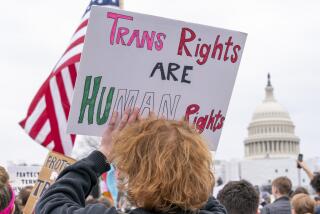Supreme Court skeptical of University of Texas affirmative action
- Share via
WASHINGTON — The Supreme Court’s conservative justices signaled Wednesday they were likely to strike down a University of Texas affirmative action policy, but did not make clear how far they might go in outlawing the use of race in admissions at colleges and universities.
From his opening question, Chief Justice John G. Roberts Jr. said he was troubled by having students “check a box” to designate race or ethnicity and by allowing officials to decide who is admitted based on this factor.
“Should someone who is one-quarter Hispanic check the Hispanic box?” he asked. When the lawyer for the university said it was up to the student to decide, Roberts tried again: “What about one-eighth?”
The case, brought by a white student who was rejected, could lead to a ruling requiring top colleges and universities to use “race neutral” policies to achieve campus diversity. Texas, for example, has required its universities, including the Austin campus where the case originated, to admit students who graduate at the top of their high school class, without regard to race or ethnicity.
Thanks to that 1997 law, about 30% of the new freshmen at the University of Texas were Latino or black. That success has undercut the university’s defense of its separate and smaller affirmative action policy.
Roberts joined Justice Antonin Scalia in questioning the university’s claim that it needs affirmative action to have a “critical mass” of minority students in its classes.
“How do they decide?” Scalia asked. “Somebody walks in the room and looks them over to see who looks Asian, who looks black, who looks Hispanic?”
Since 2006, when Justice Samuel A. Alito Jr. replaced Sandra Day O’Connor, the court has had five justices who are skeptical of affirmative action. But Wednesday marked the first time since then that the high court had heard a constitutional challenge to a race-based college admissions policy.
Alito said he was surprised to learn that the Texas university seeks blacks and Latinos from affluent families. “I thought the whole purpose of affirmative action was to help students who come from underprivileged backgrounds,” he said.
He was referring to a passage in the University of Texas brief that said the university may wish to give preference to a black student with professional parents and from a good Dallas-area high school over a black or Latino who earned top grades at an overwhelmingly black or Latino high school.
Under the Texas law, the university must admit top graduates of all state high schools. That policy has succeeded in steadily raising the percentage of Latino and black students. In the last two years, more than 80% of these minority students won admission through the law rather than affirmative action.
For a number of years, the law granted automatic admission to those in the top 10% of their class, but at the moment it is the top 8%.
But after the Supreme Court upheld affirmative action in 2003, Texas officials opted to use a race-based policy for about one-fourth of the entering class. This allowed the university to admit qualified minority students who did not graduate in the top of their class.
Alito said he did not understand why the university would give a “leg up” to a minority from a wealthy family over a similarly qualified white or Asian student who came from a middle-class family.
“We want minorities from different backgrounds,” replied Gregory Garre, the Washington attorney for the University of Texas.
“So what you’re saying is that what counts is race above all else,” said Justice Anthony M. Kennedy, who is likely to cast the decisive vote in the case. “You want underprivileged of a certain race and privileged of a certain race.”
Joined by Justice Clarence Thomas, whose opposition to affirmative action is well known, Kennedy and the court’s conservative bloc could strike down the Texas approach and put new limits on affirmative action in colleges and universities.
During the hourlong argument, the justices did not hint whether they would go so far as to overturn their 2003 ruling upholding affirmative action at the University of Michigan and forbid the use of race entirely. Retired Justice O’Connor was in the courtroom to listen to the argument, as if to remind her former colleagues of the importance of precedents.
But Kennedy has steadily opposed affirmative action and insisted before that school officials try race neutral policies, such as the Texas law, to achieve diversity.
Bert Rein, the attorney for Abigail Fisher, the rejected white applicant, sounded that theme. He said there was no need for a race-based affirmative action policy at the University of Texas because large numbers of Latinos and blacks were admitted as top high school graduates.
“Race should have been a last resort. It was a first resort,” Rein said.
U.S. Solicitor Gen. Donald Verrilli Jr. cautioned the justices about reversing course on affirmative action. He said colleges and universities had adopted admissions policies that allow for a limited consideration of race based on the court’s rulings.
College officials should be allowed the flexibility to design admissions policies that bring a diverse group of students to their campuses, he said.
It probably will be several months before the court hands down an opinion in Fisher vs. University of Texas. Regardless of the outcome, it is unlikely to affect states such as California, Washington, Florida and Michigan, where race-based affirmative action is already prohibited.
Only eight justices will decide the case because Justice Elena Kagan, a former solicitor general, withdrew. The three remaining liberal justices spent part of Wednesday’s argument time suggesting the court should throw out Fisher’s case because she had graduated from Louisiana State University.
More to Read
Sign up for Essential California
The most important California stories and recommendations in your inbox every morning.
You may occasionally receive promotional content from the Los Angeles Times.














